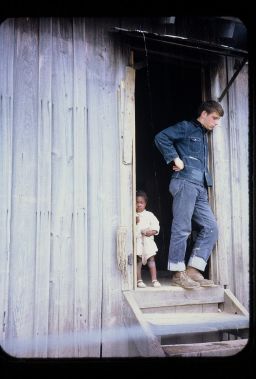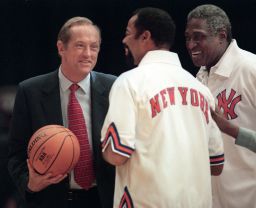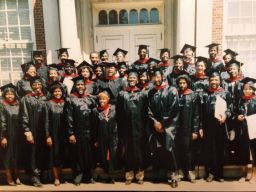Story highlights
What happens when whites live in in a black world?
White student at black school: Your vision shifts
Some still can't define what being black means
Why you should never say "I don't see color"
Flip open Amanda Shaffer’s high school yearbook, and you’ll notice something that stands out even more than her classmates’ earnest smiles and big hairdos.
Only a handful of white faces appear among the portraits of African-American students – flecks of white on a canvas of black and brown. One of those faces belongs to Shaffer, who was bused to a black high school in Cleveland, Ohio, after refusing to follow her friends to a white, private academy.
For three years, Shaffer was the only white person in the room. She had to learn how to fit in, how to not say the wrong thing. She had to deal with the peculiar sensation of being the only white girl in the bleachers as jittery white basketball teams entered a raucous gym filled with black people.
“It shifted my point of view,” Shaffer says. “It’s like when you go to the optometrist, and they slap those new lenses on you – you see the world differently.”
At least some do. A co-owner of the NBA’s Atlanta Hawks recently offered another perspective on race when he complained in an email that the presence of too many black fans at Hawks’ games scared away Southern whites who are “not comfortable being in an arena or a bar where they are the minority.”
Bruce Levenson, the owner, resigned. But the focus on his remarks ignored the perspective of people who actually have a lot of practice at being the only white person in a black crowd. They are whites who, by choice or necessity, lived in an all-black world. They became the white minority.
There’s a long tradition in America of people offering unsolicited advice to racial minorities on how to blend in. But there’s no instruction book for those who struggle with an experience that one white NBA player described as “the loneliness of being white in an all-black world.”
It’s not all racial angst, though, says one civil rights activist who left his all-white upbringing in Vermont to live for two years among black residents in Mississippi, where he discovered R&B singer Otis Redding, okra and black preaching.
“I lived in a completely black world; every couple of weeks, I looked in the mirror to remind myself that I was white,” says Chris Williams, who was then an 18-year-old volunteer for a civil rights campaign known as Mississippi Freedom Summer.

What did he learn? Williams and others with similar experiences gave this minority report.
You learn to imagine
He was a raised in a small town in Missouri and went on to become a Rhodes Scholar, a U.S. senator and a presidential candidate. But some of the most important lessons Bill Bradley learned came on the basketball court as a player for the New York Knicks.
Bradley joined a team dominated by black superstars such as Willis Reed, Earl “The Pearl” Monroe and Walt Frazier. Off the court, though, the team’s hierarchy was reversed.
“When I was a rookie, I was getting a lot of offers for commercials and my black teammates, who were better, were not getting any,” he says.
Bradley got something else that he says was invaluable – a glimpse into the private lives of black people. He shared rooms, meals, bus rides and long conversations off the court with his black teammates. He saw the constant racism they experienced and how it fed their anger.
He knew what it felt like to be outsider because he had become one.
In a speech he once gave to the National Press Club, Bradley said:
“I better understand distrust and suspicion. I understand the meaning of certain looks and certain codes. I understand what it is to be in racial situations for which you have no frame of reference. I understand the tension of always being on guard, of never totally relaxing …
“I understand the loneliness of being white in a black world.”
Bradley eventually made the NBA Hall of Fame. He’s become one of the country’s most insightful voices on race.
“Race relations are essentially exercises in imagination,” he says today. “You have to imagine yourself in the skin of the other party. So that means if you’re white, you have to understand certain realities.”
Other white sojourners in a black world say you have to learn to take advice or even orders from a person of color.
One man had to do both to stay alive.
When Williams went to Mississippi in 1964, he had to live with black families because many local whites detested Freedom Summer volunteers. They taught him how to become a part of their community and protected him. One black man saved his life by pulling him away from a white mob.
Williams says white Freedom Summer volunteers had to abandon the notion that they were there to rescue black people. They weren’t going to Mississippi to become civil rights leaders, an organizer told them.
“He said the civil rights leaders were already there; you go down there and help them,” recalls Williams, now a retired architect who still lives in his boyhood home in Vermont. “He said that they know what needs to be fixed, and they’ll tell you.”
You learn what people really think
The Public Religion Research Institute recently caused a stir when it released a poll that said three-quarters of white Americans have no nonwhite friends. Some commentators invoked the survey to explain why some whites seem clueless about racial sensitivities: They know no people of color to give them a different perspective.
White minorities in black communities say they have no problem hearing another racial perspective. They often hear more than they should.
The Rev. Curtiss Paul DeYoung says black people became so familiar with his presence when he joined an all-black church in Harlem and later attended the predominately black Howard University in Washington that some called him a “white Negro.”
“People didn’t change who they were when they talked to me,” says DeYoung, now director of the Community Renewal Society in Chicago, a faith-based group created to eliminate race and class divisions.
“When you get into racially mixed situations, we change who we are and clean up our thinking in mixed settings,” he says.
Black people let it rip in front of him, though. Once during a class at Howard, a black classmate talking about the country’s first settlers declared that “all white people are criminals.”
“I quickly understood that this was not a personal attack on me,” DeYoung says. “People were very welcoming to me personally, but she was talking more about institutional racism.”
DeYoung met a black student at Howard whom he later married. They remain married today and have two adult children.
“The woman who made that comment in class found out later that I was engaged to my wife and came up to me and said, ‘Welcome to the family,’ ” DeYoung says.
Other whites who spent time in all-black communities say they started noticing remarks from their white family and friends that were just as raw.
Shaffer, the white student who was bused, says she realized that her father called black kids “pickaninnies” and her brother called Puerto Ricans “Spics.” She heard whites talk about “Jewing” prices down and warning others to wipe a soda can before drinking because “you don’t know if a black person touched it.”
“I just started noticing this subtle and casual racism that nobody around me questioned,” says Shaffer, who is now an activist and director of faculty development at Case Western Reserve University in Ohio.
You see fear
Shaffer picked up on other things as well, such as the fear in some white faces when they moved into a black setting.
When she attended basketball games at her high school, Shaffer says, she would often be only one of two white girls in the crowd when white high school teams visited. It was like a disembodied experience – she could step outside of her whiteness and watch with bemusement as nervous whites entered her school gym.
“One of the things I noticed is that they weren’t actually making eye contact with people on the other side of the court,” says Shaffer, who wrote about her experience in an essay entitled “Busing: A White Girl’s Tale” for an online magazine, Belt.
“They were in a place where there were more black people than white people and that is not usual for white people,” she says.
Some white minorities become more afraid of what they see inside themselves.
When DeYoung was in college, he decided he was going to introduce himself to an attractive white freshman he spotted. But when he saw that woman walking across campus with two black men, he suddenly lost interest.
DeYoung rummaged through his mental attic to figure out why. The answer humbled him. He was a man who grew up buying the Rev. Martin Luther King Jr.’s speeches and watching his father pastor a multiracial church, but he unearthed something ugly.

“I had fallen prey to the stereotype that a white woman involved with a black man is damaged goods, which goes back to the slave masters who taught people that black men were sexual animals,” he says. “I thought, ‘I don’t have prejudice,’ and then one of the oldest stereotypes struck me right in the face.”
It can all sound so draining – checking your motivations, trying not to offend black people. Isn’t it easier to just declare as a white person that you don’t see race?
DeYoung says that’s actually a subtle way of insulting people of color.
“It diminishes people to not see their race and their culture,” says DeYoung, who wrote a memoir about his racial journey entitled “Homecoming: A White Man’s Journey through Harlem to Jerusalem.”
“The reality is that race affects people’s lives, and if you can’t see race, you can’t see the life they’ve lived.”
You don’t become an expert on race
There’s a scene in the 1998 film “Primary Colors” in which a white Southern political operative tells this to a staid, uptight black campaign worker:
“I’m blacker than you are. I got some slave in me. I can feel it.”
That scene captures a character familiar to some blacks: the white person who considers himself an honorary black person because he has a black girlfriend and likes hip-hop music.
Yet white people who spend time in an all-black setting seem to reach another conclusion:
“I don’t think I can understand what it means to be black,” says Williams, the Freedom Summer volunteer who joked that he forgot he was white. “It’s much more than being a minority. It’s a whole history.”
That’s something Joshua Packwood learned when he became the first white valedictorian at Morehouse College, a historically black college in Georgia that counts King as one of its graduates.
He says the black students he encountered were everything from punk rockers to hipsters to skateboarders to political conservatives who opposed affirmative action.
“If you ask me to define what black is, I’m not sure I can,” says Packwood, who now lives in New York City with his wife and son and is the co-founder of Red Alder, an investment company.
Some whites who found themselves in the minority wrestled with a fear that’s familiar to many people of color: Will people ever see past my race?
“I also have to ‘prove’ myself over and over again,” DeYoung wrote in his memoir, “Homecoming.” “Some persons of color may never fully trust me because I am white.”

The constant awareness of one’s race can be exhausting. DeYoung quoted the theologian Howard Thurman in his memoir:
“The burden of being black and the burden of being white is so heavy that it is rare in our society to experience oneself as a human being.”
But sometimes those moments can happen, as DeYoung learned by accident.
One day, DeYoung was looking through a journal he started keeping after he joined the church in Harlem. He noticed that the word “black” rang through every passage: I’m going to this “black church,” I’m eating “black food,” I’m making “black friends.”
He recalled that no one at the Harlem church had ever placed a racial modifier before his name.
“Never once in that entire year did they refer to me as being white,” he says. “I was just a member of the congregation. I was a child of God.”
DeYoung kept reading and scanned the journal entries that came after he spent more time in the church. He noticed he was still writing about making new friends, listening to gospel and eating good food.
The word “black,” however, had disappeared from his journal. They were no longer “the other.” He was no longer an outsider.
He was at home.




